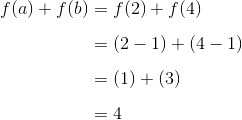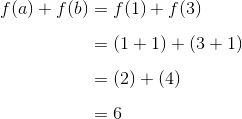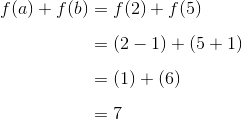This page is part of my unofficial solutions manual to the GRE Paper Practice Book (2e), a free resource available on the ETS website. They publish the questions; I explain the answers. If you haven’t worked through the Practice Book, give Section 6 a shot before reading this!
6.23: Piecewise-Defined Functions
The function in this problem is what we call piecewise-defined, meaning that a different “piece” of the function comes into play depending on what value of x is specified. You can think of such a function as a tiny computer program that
- checks to see what subdomain x belongs to.
- performs the appropriate operation from a list of possibilities.
Here, the function accepts only integers. It isn’t defined at all for other numbers, so expressions like f(π) don’t make sense in the context of this problem. When x is even, the function subtracts 1; for example, f(2) = 1. When x is odd, the function adds 1, so f(3) = 4.
The expression
means that we run the function on two numbers a and b (these can be different numbers, or they can be the same) and add together the results. The equation
means that the sum of the output (what comes out of the function when we run it on a and b) is equal to the sum of the inputs (the a and b that we start out with).
Now, because the function’s behavior depends on whether x is even or odd, we have three basic possibilities in choosing our values of a and b:
- Choose two even numbers as our inputs.
- Choose two odd numbers as our inputs.
- Choose one even number and one odd number.
If both inputs are even (e.g., a = 2 and b = 4), the function will subtract 1 from each input:
So the sum of the output (4) is less than the sum of the input (6). We’ll get a similar inequality for any two even numbers (a, b) because the function will subtract twice.
If both inputs are odd, (say, a = 1 and b = 3), then the function will add 1 to each input:
In this case, the sum of the output (6) is greater than the sum of the input (4). This will be the result any time that both a and b are odd.
But if one input is even, and the other one is odd, then the addition and subtraction will cancel out. Let’s try a = 2 and b = 5:
Of the three options we’ve tried, only this one fulfills our initial condition of
Now, looking at our answer choices, we see that only one of them can be true when a is even and b is odd, or vice versa. We can rule out answers (A), (B), (D) and (E), because they all imply (or explicitly state) that a and b have the same parity (i.e., both even or both odd). That leaves correct answer (C), which not only permits the integers to have different parities, but requires it: in order for two integers to have an odd sum, one of those integers must be even and the other one odd.
Math Review Reference
For more on this topic, see the following sections of the GRE Math Review:
- 1.1: Integers (p. 2)
- 2.6: Functions (pp. 24-25)
- 2.9: Graphs of Functions (p. 37)


